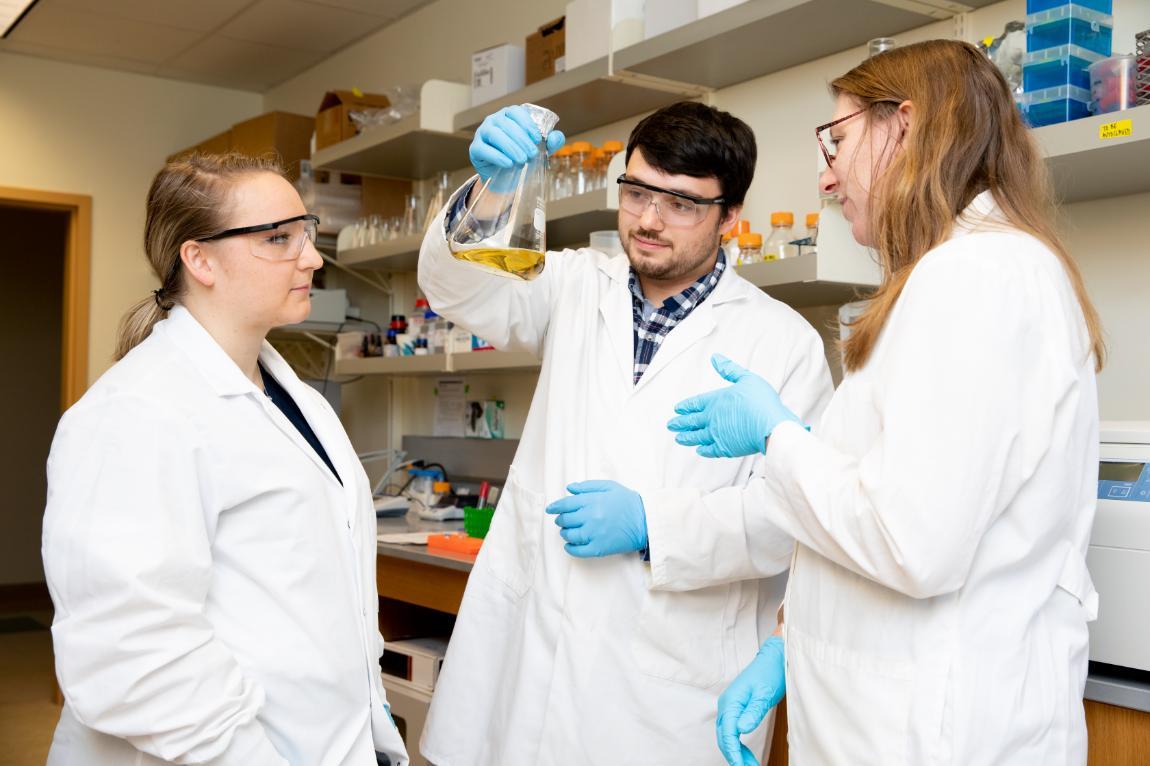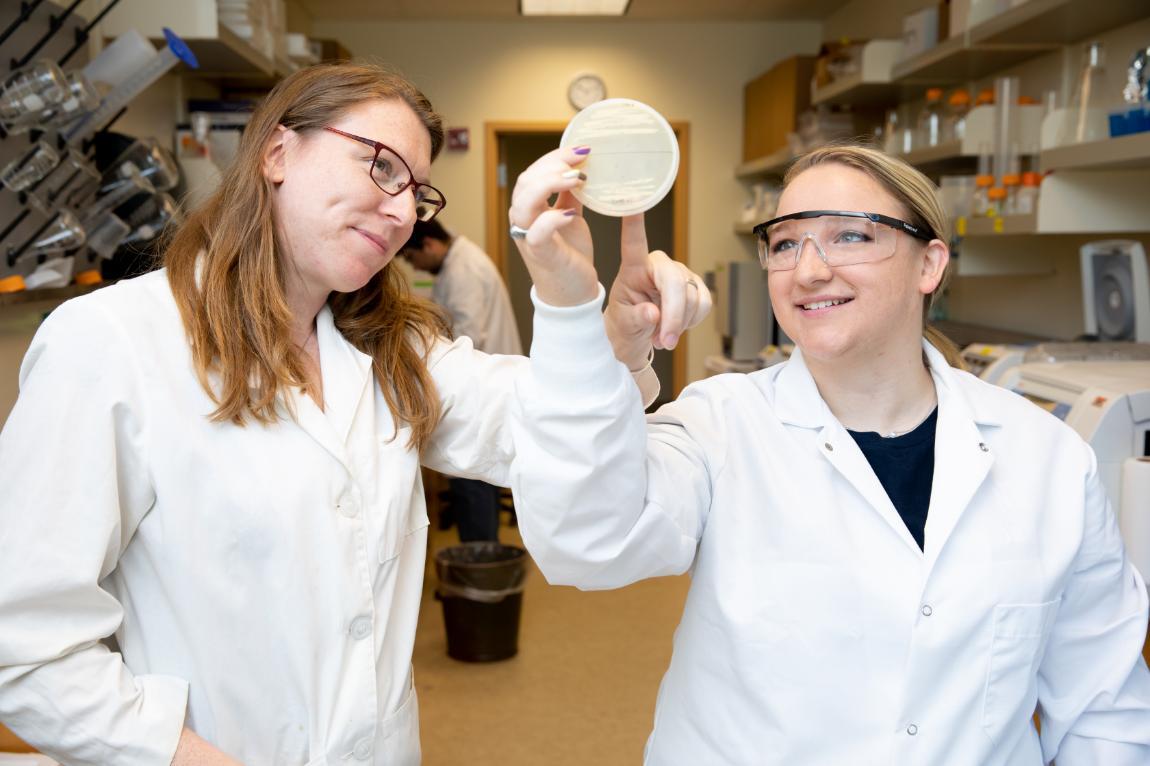Last summer, Caitlin Harris ’20 was working in a factory alongside her father. This summer, the rising Longwood junior is studying DNA repair proteins and cancer mutations alongside Dr. Erin Shanle. And the biology major couldn’t be more in her element.
Harris, who is from Chesterfield, is one of the selected students who are completing eight weeks of intensive research this summer through Longwood’s signature PRISM summer research program.
The program combines practical training in specific research techniques with activities designed to put research into the context of larger goals. Through one-on-one collaboration with a faculty member, students make significant strides on special projects across the science, technology, engineering and mathematics fields.
While this is Harris’ first summer doing a PRISM project, she has been working on similar research in the biochemistry lab for the past academic year—and the research is likely to continue until she graduates.
Below is a Q&A with Harris and Shanle, assistant professor of biology, about their PRISM project and the one-on-one research opportunities Longwood provides.
Q: Can you explain what your PRISM research project is about in a nutshell?
Harris: Our cells have DNA in them, and that’s how our bodies recover from everything. But our DNA can be broken by things like sunrays. What happens when you get a sunburn is your skin sheds because your cells are dying because your DNA is broken. We are looking at a specific complex that helps in identifying when there’s been a break in your DNA, in order to repair that. The complex is made of three proteins, and we are looking at only one of the proteins, called MRE11, because the other two proteins have been studied before. We want to see if these mutations that occur in human cancers actually disrupt that function of that protein. We are using yeast as a model organism because the DNA from humans and yeast are very similar. It was really cool recently when we finally made the mutations in MRE11.
This is an exceptional hands-on experience, and I know I’m very fortunate to have the chance to work one-on-one with a professor.
Caitlin Harris ’20 Tweet This
Q: When did this project start, and how long will it last?
Shanle: Caitlin has been working with me since last fall, which is when this project started. Then she decided she was interested in doing PRISM, so we continued the project through this summer. I tell the students who work with me that you can’t get but so far in one semester. To really try to answer a question or do a more complete study, you need to commit to multiple semesters and experiences. That is a longer-term commitment on my part, too. When I take on a student to do research, I am making sure that I am going to commit to working with them until they graduate. Most students are interested in that. My other PRISM student this summer, Barry Manchester ’19, has been doing research with me since I got here in the fall of 2016, so this is his second summer doing PRISM. He’s a protein purification guru in the lab. He was so excited to work on research that he contacted me before I was even on campus.
Harris: I like being in the lab and I like doing experiments. I could be in the lab for 12 hours, and it would be perfectly fine. Once we finish this project this summer, then we are going to ask a new question related to the same research and continue on. Maybe we will look into the other mutations or look into why the yeast don’t survive the DNA damage. We can take the research in a variety of different directions.

Q: How did you decide to come to Longwood? Was the opportunity to conduct undergraduate research a factor in your decision?
Harris: I started out at a larger university where my chemistry professor didn’t know who I was, but, when I told her I was transferring, she said I wouldn’t have the same type of research opportunities at Longwood. She couldn’t have been more wrong. I came here because I wanted a smaller school and a smaller community. I had 300-plus students in my classes there, and I didn’t feel comfortable asking teachers for help. That’s certainly not the case here at Longwood.
Shanle: When I did my teaching and research postdoctoral work at the University of North Carolina, I taught at UNC Pembroke. That university is similar in size to Longwood and is mostly undergraduates. The research opportunities offered students valuable one-on-one instructional time with professors. That experience really solidified my goal of teaching at a smaller undergraduate institution. I decided I did not want to go to a large research-intensive institution because I want to teach. At a smaller institution like Longwood, research is really rewarding on both ends, for the student and for the professor.
Q: What do you find most rewarding about the PRISM program?
Shanle: I like to provide the same opportunities that I had when I was an undergraduate because I was a lot like Caitlin. I loved being in the lab. I loved to do polymerase chain reactions, which is a method to rapidly copy pieces of DNA. I was amazed that you can make more DNA in a tube. That’s how I got bitten by the bug. My adviser at the time recognized something in me that I didn’t have any understanding of yet. I hadn’t really thought about doing research as a career. But he said, you have to go to graduate school. So I went to graduate school, and I was successful there. It was that professor who really provided the opportunity for me that changed my trajectory. Before that, I was working at a bank and I was going into finance. That’s what I hope to do for this next generation of students like Caitlin. Plus, it’s fun, and I still love to work in a lab.
Harris: Last summer I was working with my dad at a factory. I’m glad to be doing this this summer instead because I’d much rather be working in a lab. It doesn’t feel like work to me. If I decide to go to graduate school, this research opportunity will be really helpful. It allows me to do what I love. This is an exceptional hands-on experience, and I know I’m very fortunate to have the chance to work one-on-one with a professor. What I’m doing now will also compliment what I will learn in my future classes.
Shanle: That’s right. When she takes genetics, she’s going to do well in that class. The same goes for biochemistry. A lot of what we do in the lab is the applied version of the lectures. So what she will learn later in lectures, she’s learning now through experience.



Leave a Comment